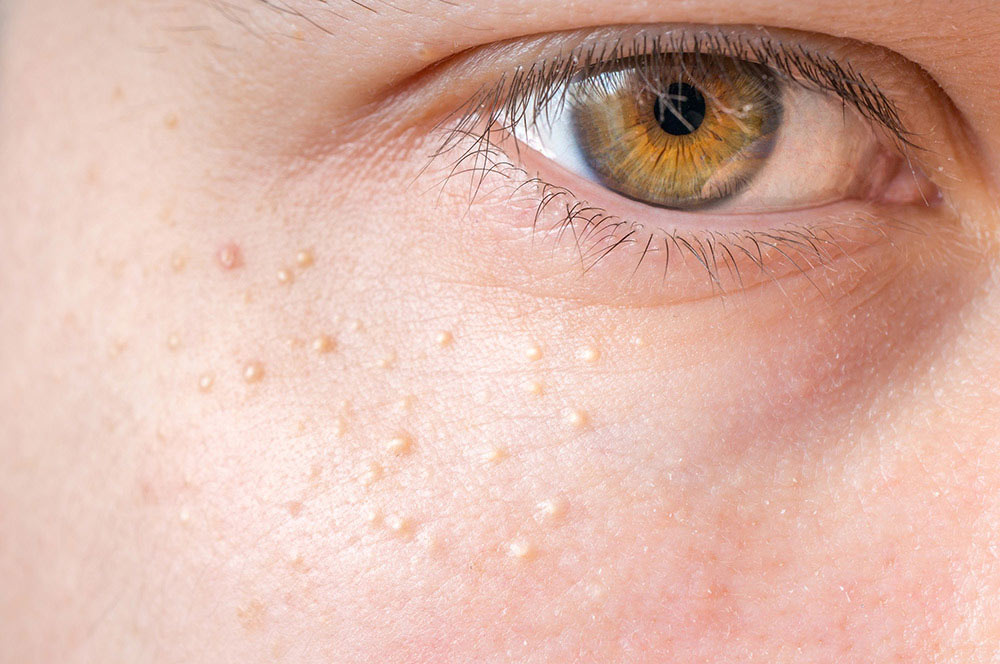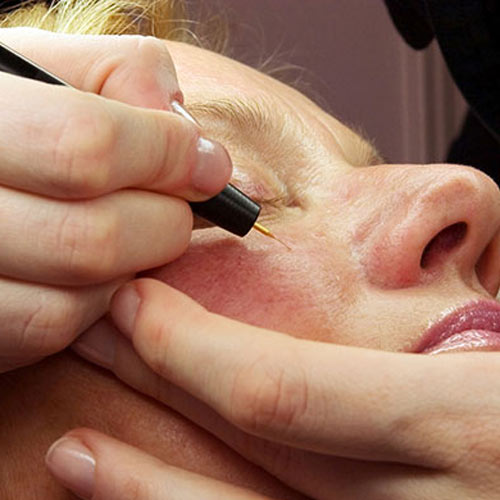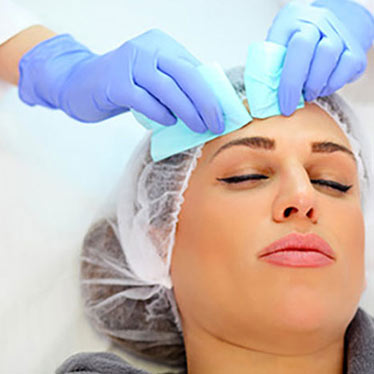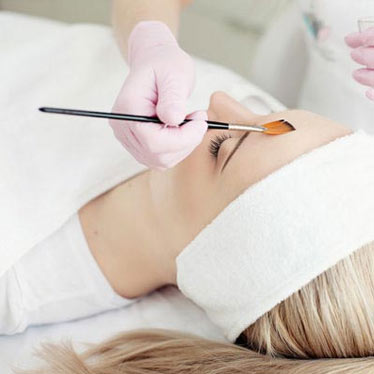Best methods for removing milia and fibromas
Milia are epidermal cysts, quite characteristic in appearance – white or yellowish dots sized from one to several millimeters, in appearance resembling semolina. They appear mostly on the skin of the face – especially on the temples, cheeks, nose or eyelids and the skin around the eyes. Milia do not give additional symptoms, e.g. itching, but their appearance is a visible aesthetic problem.
Removal of such changes should be done with caution, using only the services of a professional SPA, beauty salon or aesthetic medicine. The most common use in this skin disease is a point laser or thermolysis device. The effects occur after the first treatment. A properly performed milia removal treatment does not cause any side effects.
Where do these skin changes come from?
Their formation is favored by the accumulation of epidermal calloused mass at the tips of hair follicles. The reasons are not fully understood. Among them are hormonal causes associated with disorders of some glands (thyroid, liver, ovaries in women), genetic tendencies or immunological causes. The basis for the formation of a millet is obstruction of the sebaceous gland outlet, in which sebum and keratin accumulate. In case of infants, their appearance is associated with the immaturity of the sebaceous glands, but later they disappear.
Newborns and milia
Such a skin change occurs in case of newborns, because their sebaceous glands are immature. Most often they are visible in the central part of the face – nose, forehead, chin.
Are these skin changes gonna disappear?
In case of newborns, these skin changes spontaneously disappear after the formation of sebaceous glands, after the first 2-3 weeks. In case of adults, it is rare that this defect disappears without interference.
To date, no clear cause has been established. It is suspected that it could be genetic, autoimmune or hormonal. In terms of skin physiology, the most common cause is improper care. After removing the milia and implementing proper skin care, the problem disappears completely and irretrievably.
Where do they appear?
Most often they appear on the face – on the temples, cheeks, around the eye sockets, and even on the lips or eyelids. They also occur under the arms and in intimate places in both men and women – on the penis and labia.
How are they different from atheromas and molluscum contagiosum?
The terms atheromas and milia are used interchangeably – however, this is a mistake. Atheromas are other defects that differ from milia in size (usually they are much larger than milia), color (they are flesh-colored), structure (they are softer and more displaceable towards the ground) and have a dark spot on the surface, indicating the obstructed sebaceous gland . Atheromas are often accompanied by inflammation, and their content has a specific smell. They can also break spontaneously, which is not possible with milia.
In turn, from molluscum contagiosum it is easy to distinguish them, because the changes caused by the virus have a hollow in the middle part.
Is this skin change contagious?
Milia are not contagious, but tend to form in clusters in specific areas of the body. They also have a tendency to recur as a result of re-filling of the bag with calloused-sebaceous mass if it has not been damaged. Therefore, it is important to choose a removal method that also eliminates the cyst itself, and not just its contents.
How do milia differ from blackheads?
What makes them different from blackheads is that they cannot be removed without first opening the skin change because the millet is a cyst (surrounded by a capsule) and located in the epidermis or epidermis – it has no connection with the skin surface.
Which treatment should you chose?
Removing this type of problem should be done with caution, using only the services of a professional cosmetologist. Aesthetic medicine can also take care of this. The most effective treatment methods for this skin defect are laser or electrocoagulation, manual puncturing and cleansing. The effects are already visible after the first treatment. Properly performed milia removal service is safe and does not cause any complications.
The removal of milia by electrocoagulation, consists in the denaturation of protein by the action of a current flowing through a single, sterile probe. The treatment is practically painless, short (a few seconds) and very effective. After drying and falling off the microstructure, no traces remain on the skin.
Chemical peels and microdermabrasion are also used in removing milia. Here several treatments should be performed to gradually reach the bottom of the skin change. These methods work well with very small and numerous changes and as a later prevention, after removing milia by any methods.
In the case of chemical peels, pyruvic acid, known for its strong cleansing and anti-blackhead properties, is most often used.
How to prevent the formation of milia?
Well thought-out home care and carefully selected treatments at the beauty salon or an aesthetic medicine doctor are very important in preventing the reappearance of changes. The key element is the correct selection of treatments and skin care, e.g. chemical peels (also in summer, with appropriate types of acids), enzymatic (enzyme peels) or mechanical (microdermabrasion). In addition, an important aspect is the daily moisturizing and gentle cleansing of the face, so that the skin has a natural protective barrier. Thanks to this, it will not become excessively keratinized and produce too much sebum, i.e. the direct mechanism leading to the formation of milia will disappear.
Are there home remedies for removing milia? Opinion of a cosmetologist
There are several methods that can be used at home, but they are not effective or can cause complications in the form of discoloration, scars or irritation. There is also no cream for removing milia or a medicine without a prescription that would be effective and quick in action.
Creams for milia contain fruit acids, e.g. glycolic acid. To achieve any effect, one needs to use them for at least 3 months. They work on the principle of peeling the skin. Acid creams cannot be used by everyone at any time of the year, so when used without proper medical history and skin diagnosis, they can cause discoloration, breakage of small blood vessels, irritation and increase the risk of sunburn.
Antiviral, antibacterial and antifungal drugs have been tested in the treatment of milia, but to no effect, since the cause of these skin changes is completely different.
What is the risk of unprofessional removal of milia?
It may cause inflammation, infection of skin changes and subsequent scars or discoloration. The very technique of opening and cleansing the change, proper disinfection and information about post-operative care are very important.
Can milia be removed all year round?
The season when it’s safe to remove milia depends on the chosen method. If we remove these skin changes with a laser or chemical peels, it’s best to do it in early spring or autumn. Using electrocoagulation or microdermabrasion, we can safely operate at any time of the year, also in summer, while maintaining sufficiently high photoprotection.
Not sure what treatment to choose? Contact us and we will tell you which one is best for you.
Write to us and ask about promotion and packages for our services. For more information, please write to us on Facebook.




